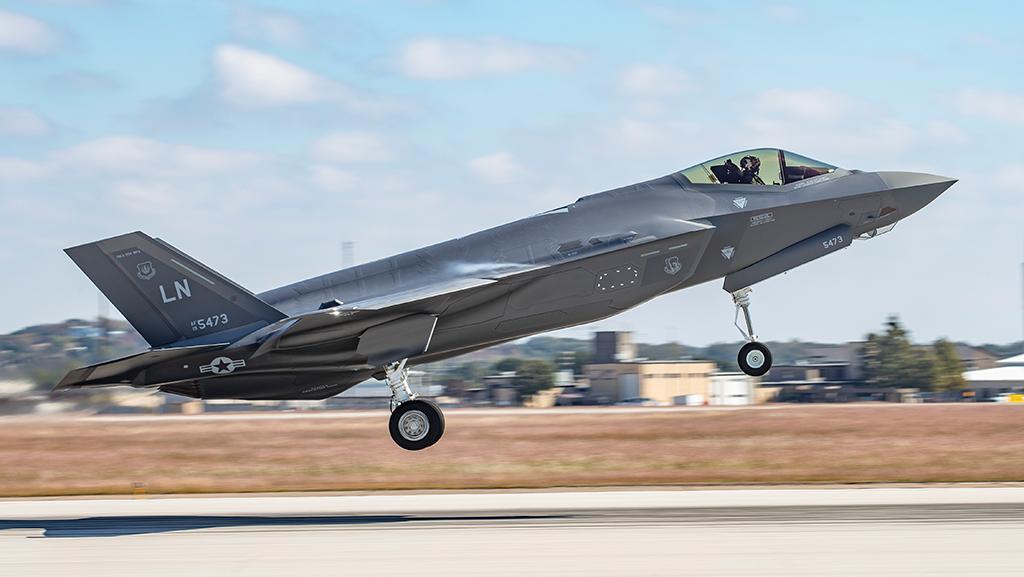
The U.S. Air Force will add to the growing tally of Lockheed Martin F-35 Joint Strike Fighters based in Europe by the end of the year: Its Lakenheath, England-based 495th Fighter Sqdn.—named the Valkyries—will be the first U.S. Air Force unit based overseas to take delivery of the fifth-generation fighter.
- Two squadrons at RAF Lakenheath will fly a total of 54 F-35s
- 495th Fighter Sqdn. should have full F-35 complement by the third quarter of 2022
Training will get underway within days of the F-35s’ December arrival, says the 495th’s commander, Lt. Col. Ian McLaughlin, as the squadron aims to build a closer working relationship with regional allies already flying the aircraft. Plans call for regular deployments and exchanges among the F-35 operators around Europe.
“On Night 1, we [will be ready] to fight together, so we need to train together on a regular basis,” McLaughlin tells Aviation Week.
The most obvious partner will be the UK, as its F-35 fleet is based just 29 mi. “down the road” at RAF Marham. McLaughlin, who served as director of operations at Hill AFB, Utah, says, “they are so close, it’s an opportunity we cannot miss from the get-go.”
The 495th pilots will use the simulators at Marham to support their training until Lakenheath’s training facilities are fully up and running. Closer relationships also will be needed when it comes to sharing the UK’s already congested airspace for training. The UK has adapted the North Sea airspace to better suit the needs of the F-35 community, providing it large tracts of airspace, but this will have to be shared by the rapidly growing UK-based F-35 community, which is expected to grow to around 100 F-35s by the middle of the decade. Current plans call for basing 54 F-35As at Lakenheath split between two squadrons, the 495th and the 493rd, which currently fly McDonnell Douglas F-15C Eagles. Also at Marham are 21 British F-35s; another 27 are on order, and more are likely to follow. McLaughlin sees opportunities to work with the Norwegian, Dutch and Italian F-35 communities, too.
Norway will soon be the first to operate only the F-35, as it plans to retire its F-16s by year-end.
The 495th Sqdn. expects to take on its full complement of aircraft by the fall of 2022. It will balloon to become what McLaughlin describes as a “super squadron,” absorbing aircraft that will be destined for the 493rd. “There is a window of 4-6 months when [the 493rd] ready aircrew, aircraft and maintainers before they get their feet under them and become fully independent,” says Lt. Col. Daniel Connors, commander of Lakenheath’s 748th Aircraft Maintenance Sqdn.
As part of its transition to the F-35, the 493rd will divest its F-15Cs, bringing to an end the type’s 40-year career in the European theater.
Normally, air force squadrons have a complement of 24 aircraft, described as Primary Aircraft Assigned. An additional six jets are considered backup inventory, should one of the units lose an aircraft to depot maintenance or upgrades, ensuring there will always be 24 aircraft available in the squadron and available to combatant commanders.
Both Lakenheath F-35 squadrons are expected to have all their aircraft by the end of March 2024. Although the F-15C will be divested, the base will continue to be home to two squadrons of F-15E Strike Eagles and will be just one of two bases—along with Eielson AFB, Alaska—that will be home to both F-35s and a fourth-generation fighter fleet.
“All the commanders see the basing of fourth- and fifth-generation fighters as an opportunity to integrate. We will fly with each other a lot more,” McLaughlin says.
With the arrival of the F-35, personnel numbers at Lakenheath will swell by an additional 1,200, many of whom will be maintainenance and support staff. McLaughlin’s pilots include a mix of F-35 veterans and pilots fresh out of training at Luke AFB, Arizona. While the pilots will be prepared for a wide variety of missions, the squadrons’ primary roles are offensive counter air and suppression of enemy air defense missions.
In preparation for the F-35s’ arrival, new infrastructure contracted by the UK Defense Ministry’s Defense Infrastructure Organization is being completed at a cost of £160 million ($216 million).
Lacking the acreage enjoyed by U.S. bases, Lakenheath’s F-35 hangars, squadron buildings and maintenance and logistics support facilities have been squeezed onto a small site between a taxiway and the base’s golf course.The F-35s also will be regularly operating from hardened aircraft shelters at Lakenheath rather than the soft shelters at other F-35 bases.
McLaughlin is eager to get started. “Within a day or two of arrival, we want to be getting our pilots familiar with the airspace,” he says. “By next spring, it will feel like a normal fighter squadron.”
Editor’s note: This article was updated to correct the number of British F-35s at Marham and clarify the F-35 type that will be based at Lakenheath.





